A few years back (April 2011 !) amongst the many other things I got to bring to kids TV I did a piece on virtual worlds and in particular Opensim. None of the shows clips are on the web any more, which is a pity as they are still useful resources in explaining things. I found a rare lost archive of my Opensim piece with Sy Thomas . So I thought I would pop it onto youtube (I hope I am not in breach of any copyright!) as a flavour of the sort of thing we put on 39 shows on Saturday morning kids tv on ITV.
Opensim is still very much alive and well and available, virtual worlds like Minecraft do very similar things. I would have done a follow up on Minecraft anyway. Equally now we have the rise of the Virtual Reality headset and immersive 3d environments are having their 3rd or 4th renaissance. Of course in this I point out that 3d creative environments are also distribution platforms for 3d printing and manufacturing.
Archie Productions (who made Cool Stuff Collective) latest fantastic film about the Lancaster Bomber airs this weekend on 21:30 on BBC2 Britain’s Flying Past So check that out too 🙂
metaverse
The future of broadcasting via super8, Wimbledon, CKD Road Trip, twitch and tango – flush 13
Another exciting monday morning as the new edition of Flush The Fashion magazine goes live.
As usual there are loads of great articles and also some great prizes to be won in the magazine. This time Kano raspberry Pi kits 🙂
On page 74 I have my article “We go live in 3.2.1…” which once again looks great with the layout and the images that @tweetthefashion put together.
I discuss the evolution of home movies from the 70’s and super 8 film to the amazing changes in being able to broadcast live right now to everyone. On the journey are the experiences of trying to some early multi platform broadcasting and virtual worlds elements at Wimbledon (which starts today so that’s good timing) to the ability to just say xbox broadcast to share your game play with commentary to anyone anywhere. Being an emerging tech section I also have to consider the wonderful Project Tango from Google too.
The full magazine is here
The ipad version will be live very soon.
This will get you to my little article
An interesting game tech workshop in Wales
Last week I took a day out from some rather intense Unity3d development to head off to North Wales to Bangor. My fellow BCS Animation and Games Dev colleague Dr Robert Gittins invited me to keynote at a New Computer Technologies Wales event on Animation and Games 🙂
It is becoming an annual trip to similar events and it was good to catch up with David Burden of Daden Ltd again as we always both seem to be there.
As I figured that many of the people there were going to be into lots of games tech already I did not do my usual type of presentation, well not all the way through anyway. I decided to help people understand the difference between development in a hosted virtual world like Second Life and developing from scratch with Unity3d. This made sense as we had Unity3d on the agenda and there were also projects from Wales that were SL related so I though it a good overall intro.
I have written about the difference before back here in 2010 but I thought I could add a bit extra in explaining it in person and drawing on the current project(s) without sharing too much of things that are customer confidential.
I did of course start with a bit about Cool Stuff Collective and how we got Unity3d on kids TV back on the haloween 2010 edition. This was the show that moved us from CITV to ITV prime saturday morning.
I added a big slide of things to consider in development that many non game developers and IT architects will recognise. Game tech development differs in content to a standard application, the infrastructure is very similar. The complication is in the “do something here” boxes of game play and the specifics of real time network interaction between clients. Which is different to many client server type applications (like the web)
After that I flipped back from tech to things like Forza 5 and in game creation of content, Kinect and Choi Kwang Do, Project Spark and of course the Oculus Rift. I was glad I popped that in as it became a theme throughout the pitches and most people mentioned it in some way shape of form 🙂
It was great to see all the other presentations too. They covered a lot of diverse ground.
Panagiotis Ritsos from Bangor University gave some more updates on the challenges of teaching and rehearsing language interpretation in virtual environments with EVIVA/IVY, the Second Life projects and now the investigations into Unity3d.
Llyr ap Cenydd from Bangor University shared his research on procedural animation and definitely won the prize for the best visuals as he showed his original procedural spider and then his amazing Oculus Rift deep sea experience with procedural generated animations of Dolphins.
Just to help in case this seems like gobbledegook. very often animations have been “recorded” either by someone or something being filmed in a special way that takes their movements and makes them available digitally as a whole. Procedural generation uses a sense and respond to the environment and the construction of the thing being animated. Things are not recorded but happen in real time because they have to. An object can be given an push or an impulse to do something, the rest is discovered but he collection of bits that make up the animated object. It is very cool stuff!
Just before the lunch break we had Joe Robins from Unity3d, the community evangelist and long term member of the Unity team show us some of the new things in Unity 5 and have a general chat about Unity. He also did a session later that afternoon as a Q&A session. It was very useful as there is always more to learn or figure out.
We all did a bit of a panel, quite a lot of talk about education of kids in tech and how to just let them get on with it with the teachers, not wait for teachers to have to become experienced programmers.
After lunch it was Pikachu time, or Pecha Kucha whatever it is called 🙂 http://www.pechakucha.org 20 slides each of 20 seconds in a fast fire format. It is really good, covers lots of grounds raises lots of questions.
David Burden of Daden Ltd went first. VR the Second Coming of Virtual Worlds exploring the sudden rise of VR and where it fits in the social adoption and tech adoption curves. A big subject, and of course VR is getting a lot of press as virtual worlds did. It is all the same, but different affordances of how to interact. They co-exist.
Andy Fawkes of Bohemia Interactive talked about the Virtual Battlespace – From Computer Game to Simulation. His company has the Arma engine that was originally used for Operation Flashpoint, and now has a spin of with the cult classic Day Z. He talked about the sort of simulations in the military space that are already heavily used and how that is only going to increase. An interesting question was realised about the impact of increasingly real simulations, his opinion was that no matter what we do currently we all still do know the difference and that the real effects of war are drastically different. The training is about the procedures to get you through that effectively. There has been concern that drone pilots, who are in effect doing real things via a simulation are to detached from the impact they have. Head to the office, fly a drone, go home to dinner. A serious but interesting point.
Gaz Thomas of The Game HomePage than gave a sparky talk on How to entrain 100 million people from your home office. Gaz is a budding new game developer. He has made lots of quick fire games, not trained as a programmer he wanted to do something on the web, set up a website but then started building games as ways to bring people to his site. This led to some very popular games, but he found he was cloned very quickly and now tries to get the mobile and web versions released at the same time. It was very inspirational and great to see such enthusiasm and get up and go.
Ralph Ferneyhough of newly formed Quantum Soup Studios talked about The New AAA of Development – Agile, Artistic, Autonomous. This was a talk about how being small and willing to try newer things is much more possible and needed that the constant churn in the games industry of the sequel to the sequel of the sequel. The sums of money involved and sizes of projects leads to stagnation. It was great to hear from someone who has been in the industry for a while branching out from corporate life. A fellow escapee, though from a different industry vertical.
Chris Payne of Games Dev North Wales gave the final talk on Hollywood vs VR:The Challenge Ahead. Chris works in the games industry and for several years has been a virtual camera expert. If you have tried to make cameras work in games, or played one where it was not quite right you will appreciate this is a very intricate skill. He also makes films and pop videos. It was interesting to hear about the challenges that attempting to do 360 VR films is going to have for what is a framed 2d medium. Chris showed a multi camera picture of a sphere with lenses poking out all around it, rather like the star wars training drone on the Millennium Falcon that Luke tries his light sabre with. This new camera shoots in all directions. Chris explain though that it was not possible to build one that was stereoscopic. The type of parallax and offsets that are needed can only really be done post filming. So a lot has to be done to make this giant 360 thing able to be interacted with in a headset like the rift. However that is just the start of the problems. As he pointed out, the language of cinema, the tricks of the trade just don’t work when you can look anywhere and see anything. Sets can’t have crew behind the camera as there is no behind the camera. Story tellers have to consider if you are in the scene and hence acknowledged or a floating observer, focus pulls to gain attention don’t work. Instead game techniques to attract you to the key story elements are needed. Chris proposed that as rendering gets better it is more likely that the VR movies are going to be all realtime CGI in order to be able to get around the physical problems of filming. It is a fascinating subject!
So it was well worth the 4am start to drive the 600 miles round trip and back by 10pm 🙂
Got back home to some amazing news. Oculus to Facebook :)
I am just about coming around from a superb trip to the US with my Choi Kwang Do family. We took a flight to Orlando, then drove 500 miles in 2 cars up to Atlanta, Georgia. The HQ of CKD. Whilst there several of the group graded for belts, a black belt and 2 coloured belts. Also the founders of the Hampshire group of schools Mr Derek Bicknell and his son Mr Liam Bicknell graded (for 2 days ) with Grand Master Choi and achieved their 4th Degree blackbelt in CKD. A very fine achievement.
Most of the time I spent at HQ, training and helping out. It is a great time to just concentrate on the art not worry about the outside world.
I did take a trip with some of our group to the aquarium and I also spent some time with an old friend from Atlanta who very kindly took me skeet and target shooting out on the wilds near Alabama for the full redneck experience. Including firing a very loud M1 rifle.
Once the training was done we then drove 500 miles back to Tampa where we attended the 27th anniversary of Choi Kwang Do at a seminar.
So I was almost completely immersed in CKD and less in tech. However… I did speak to some people about the kinect and how that could help training and I also explored making videos on the fly. I had made some using the iMovie trailer wizard before but I attempted a couple of live ones. The first was when I took a break from driving and made this.
The second was attempting to document the aquarium experience. Atlanta aquarium provides very fast wifi which make a lot of sense so we can all share things as we are doing them. This was the result.
The wifi at the seminar let me capture and publish straight to youtube too, such as Miss Cullen’s shield attack which she gained a great 3rd place and a handshake from Grand Master Choi.
I had videos all the demo teams too, I was about to upload them when I realised that they are all performed to music that probably would get flagged by the google bot and get takedown orders on them. So that requires a bit more editing not on the iPhone 🙂
On getting back and feeling enthused by jet lagged I was pleasantly surprised to find that Facebook was buying Oculus Rift the VR headset. Now I understand the notion that a big company has just bought out something slightly cool because it was not mainstream but as a metaverse evangelist and as part of this industry I think it is very good news. That combined with Sony’s Morpheus headset and the potential combination of Google Glass and Google Tango means we have a resurgence in the very thing that people keep asking if its dead. Virtual worlds. Headsets provide another way to interact with 3d content. It may not be to everyone’s taste, there is a barrier to entry. However big tech firms showing an interest again will push things forward back up the good side of the hype curve.
Issues of identity, of immersive design, integration with existing data. New ways to explore how we communicate as humans all get brought to the fore. It will give another generation a chance to push things forward. I am of course happy to help anyone get to grips with the changes this will bring. I have been in this virtual space quite a while now, though there are other pioneers that were there before too.
So bring it on 🙂 It would be amazing to be up close and personal with digital renditions of all the wonderful Choi Kwang Do experts in an immersive 3d environment too. There are of course slight practical issues of wiring getting in the way, but it would be possible to get a complete perspective of the art from the view of a grandmaster captured digitally. Not to replace the real physical thing, but it would be great to feel that peace and excitement of the Atlanta HQ from here 🙂
A simple virtual world use case – learning by being there
With my metaverse evangelist hat on I have for many years, in presentations and conversations, tried to help people understand the value of using game style technology in a virtual environment. The reasons have not changed, they have grown, but a basic use case is one of being able to experience something, to know where something is or how to get to it before you actually have too. The following is not to show off any 3d modelling expertise, I am a programmer who can use most of the tool sets. I put this “place” together mainly to figure out Blender to help the predlets build in things other than minecraft.With new windows laptop, complementing the MBP, I thought I would document this use case by example.
Part 1 – Verbal Directions
Imagine you have to find something, in this case a statue of a monkey’s head. It is in a nice apartment. The lounge area has a couple of sofas leading to a work of art in the next room. Take a right from there and a large number of columns lead to an ante room containing the artefact.
What I have done there is describe a path to something. It is a reasonable description, and it is quite a simple navigation task..
Now lets move from words, or verbal description of placement to a map view. This is the common one we have had for years. Top down.
Part 2 – The Map

A typical map, you will start from the bottom left. It is pretty obvious where to go, 2 rooms up and turn right and keep going and you are there. This augments the verbal description, or can work just on its own. Simple, and quite effective but filters a lot of the world out in simplification. Mainly because maps are easy to draw. it requires a cognitive leap to translate to the actual place.
Part 3 – Photos
You may have often seen pictures of places to give you a feel for them. They work too. People can relate to the visuals, but it is a case of you get what you are given.

The entrance
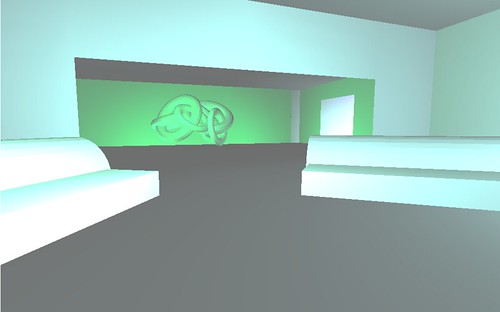
The lounge
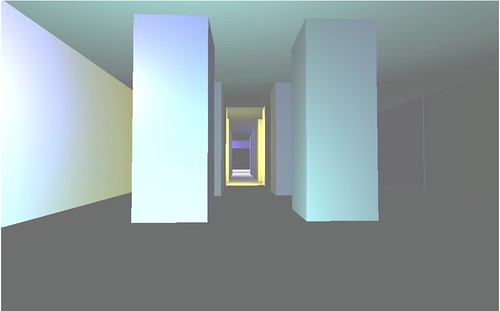
The columned corridor
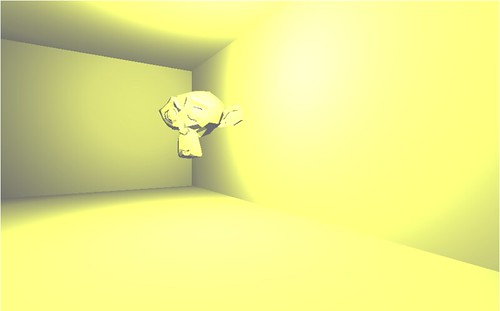
The goal.
Again in a short example this allows us to get quite a lot of place information into the description. “A picture paints a thousand words”. It is still passive.
A video of a walkthrough would of course be an extra step here, that is more pictures one after the other. Again though it is directed.You have no choice how to learn, how to take in the place.
Part 4 – The virtual
Models can very easily now be put into tools like Unity3d and published to the web to be able to be walked around. If you click here, you should get a unity3d page and after a quick download (assuming you have the plugin 😉 if not get it !) you will be placed at the entrance to the model, which is really a 3d sketch not a full on high end photo realistic rendering. You may need to click to give it focus before walking around. It is not a shared networked place, it is not really a metaverse, but it has become easier than ever to network such models and places if sharing is an important part of the use case (such as in the hospital incident simulator I have been working on)
The mouse will look around, and ‘w’ will walk you the way you are facing (s is backwards a,d side to side). Take a stroll in and out down to the monkey and back.
I suggest that now you have a much better sense of the place, the size, the space, the odd lighting. The columns are close together you may have bumped into a few things. You may linger on the work of art. All of this tiny differences are putting this place into you memory. Of course finding this monkey is not the most important task you will have today, but apply the principle to anything you have to remember, conceptual or physical. Choosing your way through such a model or concept is simple but much more effective isn’t it? You will remember it longer and maybe discover something else on the way. It is not directed by anyone, your speed your choice. This allows self reflection in the learning process which re-enforces understanding of the place
Now imagine this model, made properly, nice textures and lighting, a photo realistic place and pop on a VR headset like the Oculus Rift. Which in this case is very simple with Unity3d. You sense on being there is even further enhanced and only takes a few minutes.
It is an obvious technology isn’t it? A virtual place to rehearse and explore.
Of course you may have spotted that this virtual place whilst in unity3d to walk around provided the output for the map and for the photo navigation. Once you have a virtual place you can still do things the old way if that works for you. Its a Virtual virtuous circle!
Oculus Rift arrived
Yesterday was a very interesting day all around. The main event for me was the arrival of my Oculus Rift development kit. This is a Virtual Reality (VR) headset. We have had these before but not ones that are this cheap (relatively) and that just plug into any machine and work with Unity3d !
It came in a cool case too. Some nice big clicking catches on it like something James Bond would get from Q.
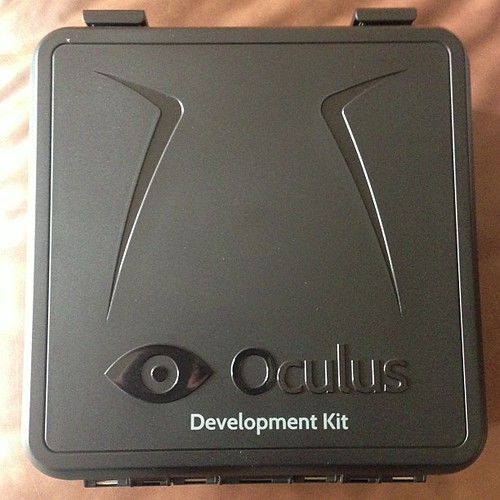
I had to dash out and get a mini display port to DVI adapter as I had that frustrating moment we have all had at some time when you realize a tiny piece of cable is missing. I only had a VGA adapter that I usually need to projectors at presentation. Handily there is a Mac store in Basingstoke and also Apple kit stocked in the nearby PC world so I had that covered in minutes.
I ran the Tuscany demo straight away. This is a small, but lovely rendered, building in the Italian countryside and on the coast. I was, despite having experienced this sort of stuff alot before suitably amazed and excited by it.
I did not hog it though and got each member of 3 generations in the house to have a go.
I was really happy that the predlets got how cool it was too. There was a suitable amount of bemusement and wonder.
The unit is two screens one for each eye and the ability to track head movements. So these head movements can then inform a game or application that you have moved you view.
The unity 3d integration is the library that is able to talk to the rift, but it is also a couple of prefabs (bundles of reusable code) that lets you change the normal single view camera to one that generates 2 views from slightly different angles to then feed to the rift screens (one per eye). Elegant and simple. It also has a controller prefab that takes the input from the headset movement and feeds that into the unity environment.
So it is not going to take to much to test some of the applications I have and make them rift enabled, though they have to be native application publications not web ones I am assuming.
It was not the only tech of the day though as in the morning Predlet 1.0 went and experienced indoor skydiving at Airkix.
Something I remember well from the TV show 🙂
She had a blast doing that.
I had a go on the iracing sim rig there had there too, this is basically a high end pc with a hydraulic chair and some force feedback steering.
We have yet to try the brush boarding or the skiplex slope (a skiing conveyer belt).
Just to juxta pose those though predlet 1.0 finished her Revell glue together and paint kit of the Titanic. Don’t worry though, it was all perfectly normal as predlet 2.0 was completing levels on Lego Indiana Jones 2 on the Xbox 🙂
InfoQ – virtual worlds interview – me again :)
As I was on the roster as the rather excellent Goto conference I was asked by Ben Linders a few questions on virtual environments and where they fit in the world of software engineering. This turned into a slightly longer interview and has just gone live. It is always interesting to frame the answers about virtual worlds into a slightly different context or industry but of course when it comes to the software industry, the fact that this is software anyway has a nice meta element to the conversation.
The article is live here.
Along with my super g33k bio picture 🙂

It is also cool that you can now just search “epredator” on infoq and tadah! 🙂
I guess this may seem more of me going on about the same things, but there is a reason for that. These technologies make a huge difference to a lot of use cases. I am getting more calls and questions again about how these may work (post bubble). Ignoring the possibilities for anyone or any industry could be costly this time around. I just want to help 🙂
Not just handbrake turns – GTA V
The original Grand Theft Auto was a great game. A top down scroller with cars that had very pleasing handbrake slides as you zoomed around the city in a sort of glorified PacMan variant. That sells it a bit short but as the creators called it that once I think I can :).
There is a complete history here on Games Radar.

I loved the top down scrolling car action not least because I had written a few demos along that sort line.Not least the cars game that was part of the developer kit with the old firms “BIG” proof of concept for in game micro transactions back in 2004 (yes they should have stuck with it but what can you do !)
So when the 3d versions of GTA started to produce more variety, but definitely keep that level of fancy driving it was fantastic.
I always have marvelled at the size of the free roaming worlds in many of the games. They just get bigger and bigger. They are not random either they are designed, intricately designed! The entire metaverse now though becomes a backdrop for narrative, not just sliding around. The good thing is though, you can ignore the story and just have some fun razzing around in cars listening to music.
If you are not a gamer and you have not watched this new video of Grand Theft Auto V the fifth installment and the latest and greatest I urge you to give it a look. Just to get a feel for the scale of these games. I am sure GTA V will not disappoint, they have just got better and better, more and more varied. They are a fantastic achievement in games and technology too.
Goto; Amsterdam part 2 of 2 –Some Choi then Makers gather
Day 2 (part 1 is here) of Goto started very early in the morning for me. I woke up and thought, hmmm I should do my Choi Kwang Do stretches and patterns, not realizing it was only 5am. Still it made me feel pretty good after the slightly heavy night out previously. Conferences are weird time shifts too, the intensity of being in conference mode needs something to balance it and this did. Besides I was going to be talking about Choi in my presentation and I had not been to class since the Saturday. It was now Wednesday!
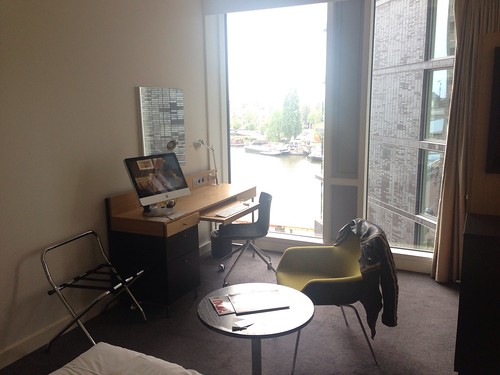
So I entered the morning keynote pretty refreshed and ready to hear some interesting things.
The twitter wall was up and running again, as were my tweets. The wifi was rock solid the whole conference too !
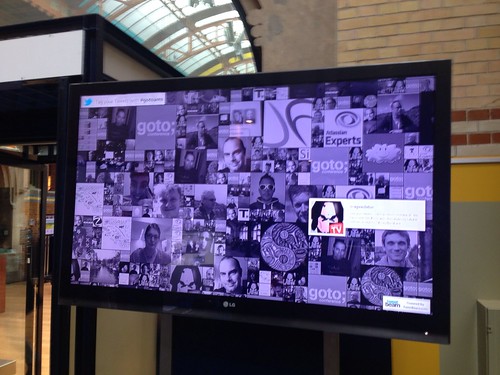
First up was Martin Fowler, author of many books I have owned and read on patterns, UML etc. He had picked a couple of his talks that he has in his kit bag. For pure software engineers these were probably very useful. Schema’s still being there when there is no Schema made sense as at some point anything needs a structure put on it.
The tracks for the day were, It’s all about the people, stupid, Agile Closing the Loop, Hard Things Made Easy, Mobile, Case Studies, Legacy Systems and our Emerging interfaces track.
I stuck with the It’s all about the people, so that I could hear Linda Rising (@risinglinda) talk again. She talked about the power of the agile mindset. This was nothing about the Agile development approach, but really about human motivations and how they get messed up depending how they are addressed. Linda cited an experiment that gave an easy test to a group of students. After the test the group was divided into to by a subtle difference. This was not revealed until the rest of the story had been told. Instead Linda introduced Fixed and Agile thinking groups. Fixed being of an attitude that any task, intelligence, talent etc cannot be improved, you stick with what you have got and make the most of it, versus an agile mindset that is not fixed but is intrigued and motivated by the challenge and the effort aiming to improve.
In the story the fixed group were asked if they wanted to take a new easy test or a new hard test. They all chose easy again. The effort/agile group chose harder tests, thriving on the challenge.
There were several elements to the research that had been done that Linda recited, but it showed that the fixed mindset tends to measure itself against others being worse, assuming it can’t improve it maximises others flaws. The agile mindset looked for challenges, understood that failure was a learning experience and enjoyed the entire process comparing only to themselves and wanting to coach others to join them.
Now it turns out the only difference in the groups in the experiment was that the fixed group were handed their results and told that they were very clever. The agile group was handed the results and told they must have worked very hard. There are lots of examples of this but also that the fixed thinking tends to be destructive. The “rank and yank” approach of Enron and other corporates that seek to measure and find “the best” cut the others out etc. which leads to a set of people only wanting to not be in the bottom of the pool. This was compared to organisations like Southwest Airlines who seek to grow people, help them get better at whatever they do.
This is all out there in research, that is obviously ignored as it is a bit scary. However, linking back to my morning Choi exercises, in CKD there is no competition.We all want to learn, we want to grow and improve ourselves and help others. Nothing is ever wrong, it is a way to learn to do it better. Instructors are helped to understand how ti give positive re-enforcement and to praise effort. I don’t often hear “you are brilliant” used about people in the art, instead “that was a great effort”. Find you limit and push a little past it, then a little more. Just strive to get better not be the best. it is so simple and effective and it works.
(It has got me pondering an evolution of my blended learning piece of the pitch that features CKD and dive more into the similarity with how to do any good team growth and nurturing based on the CKD experience.)
The next presenter was Simon Brown on Sustainable competence – the people vs process and technology. This was more of a consulting experience presentation, but about the same subject. How and where it works to let people take an agile approach. It also was important to point out that Agile as a buzzword did not mean quick nor sort it out without the complications of design, build and test. In fact the examples were all of how teams that trust one another and are self organised take time. It is something that needs to be trusted to get on with itself. I had flashbacks to previous teams and how we tried to do that (without the Agile word). Always a corporate control freak would try and crush it at the wrong time.
A spot of lunch and then it was me. 50 minutes of cool stuff collective, games tech, 3d printing etc. It is my same slide deck, in a slightly different order but it is here and if you were there it might make sense 🙂 I felt the crowd were engaged and enjoying it. There were some interesting shows of hands, or not to some of my questions to see who did what where. 80% of people knew about 3d printing but the viral nature of reprap was a surprise to many.
I was really glad that all of us presenting had some freaky and interesting things to say but in particular next up after I had shown some custard pies being thrown (usually quite hard to follow) Daniel Hirschman @danielhirschman had more than enough to follow that madness. He has several angles to his work. As an artist and physical designer he has a different perspective to developers. However he also wants the world to learn to code, to be a maker to hack. This is a very cool combination. He is a fan of the Arduino and of processing, and builds real things with it.
This was fantastic, all built with arduino and some other hacks to make a corner shop a musical instrument for a beer advert by his company Hirsch and Mann ltd. Check out the other work, like the Turin interactives at the science museum.
However he also showed lots of the work too of his educational company Technology Will Save Us that makes kits with arduino and alike to let kids or any makers play with an idea and build some interesting things. His final mad example was Bright Eyes. Which he got a kickstarter going for and raised some funds
(We speculated that Andy Piper would have been one of the backers, and yes he is :))
These came out later at the party. They were very popular.
We then changed tack to several lightning 10 minute talks. We had kinect for shop windows being demoed, Dan (@mintsource) showed a clever web sockets sort of local network distributed pub quiz with real prizes. I missed out by 1 point on a prize grrr. Dan also showed Leap motion working.
I did a quick piece on Unity3d and hospitals it was great to be able to talk a bit about code and how it worked. For my own brain it was good but also to not just be the crazy virtual world guy 🙂
It was a maker fest really 🙂 It all seemed to fly by and lots of people wanted to talk afterwards to it seemed to hit the nail on the head.
I had not mentioned this conference had lots of breaks, good 30 minute ones. Not a quick 10 minutes to dash to the next talk, but ones to stop, chat, reflect etc. It’s pacing was really good. They have been doing it a while though.
The final keynote was different in that we all stood up. The chairs had gone. The speaker was Mike Lee @bmf He was talking about the App universe after the big bang. It was a war story presentation, and he admitted to being a bit jet lagged after the alternative WWDC conference he had run. He is ” Mayor of Appsterdam” and brought a typical ebullient American delivery but blende with a love of the art and culture in Amsterdam. His main thing was “don’t make games” basically he was saying it is not going to make you rich and it is too hard. He is making games, he is suffering for his art. He managed to get his plug in at the end, but as it is an educational game, or at least one that tries to blend learning and fun it is worth a look. It was entertaining and depressing in equal measure, but finished with the line “lets go drink beer”.
We all stayed at the venue for a while as it was meet the speakers time, and as a speaker I was there to be met 🙂
Then it drifted back to what must have become a very expensive bar bill at the hotel.
As mentioned the Brighteyes came out, but the also went head ot head with a Google Glass rig (and won)
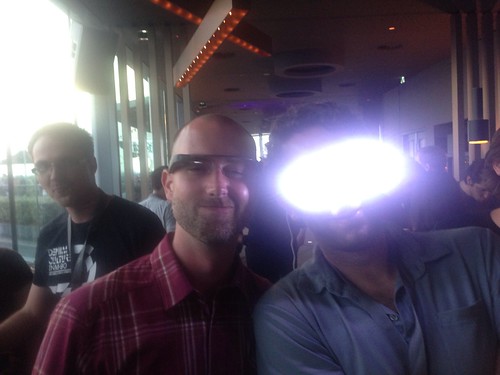
It was also very cool that the father of OTI and VisualAgeSmalltalk and Java Dave Thomas also took to them 🙂
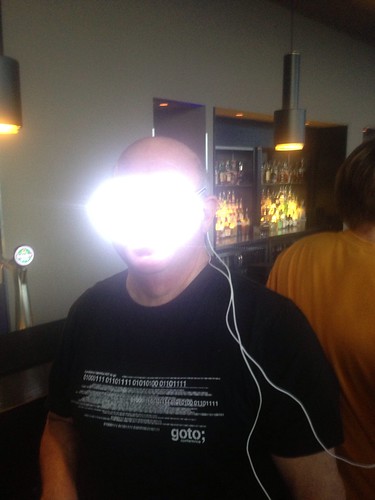
Anyway I had some awesome chats with people, made some great contacts, enjoyed what I heard and had a great trip.
So thankyou again Gotocon and trifork
Rez Day again – Reflection on 7 years of joy and pain
All the joys of trying to move physical home and my focus on training in Choi Kwang Do, plus the Predlets being on holiday meant my Rez Day in Second Life nearly passed me by! It has been just over 7 years now since diving into SL and that has been a catalyst for a great number of changes and opportunities (and quote a few threats) in my life and the lives of many of my friends and colleagues.
I am still amazed at the power of what happened back in 2006 the power of people to gather and share in a virtual space. The creativity and buzz is something that many of us will never fully experience again.
This may seem crazy but this formed part of a customer briefing on security!
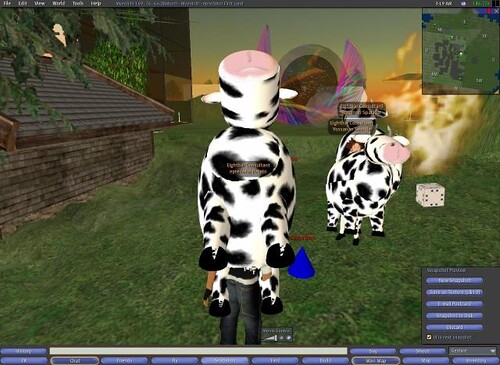
We really didn’t know the potential(which is still there), we just knew that exploring code and shapes, interactions with people etc was going to take us somewhere. I mean what do you do when your scripted space hopper rolls away into someone else space?
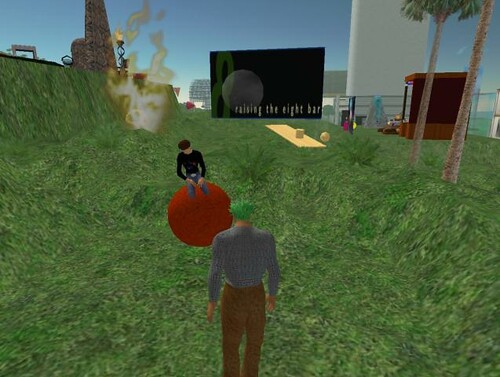
There are not many pieces of software that you can look back on and say that of. Of course the software, the networks etc was just an enabler for people to communicate and explore.
I have a collection photos of real events that happened in world. These are as memorable to me as any other photo or holiday snap. Real people doing real things, just mediated through bits and bytes.
I am still amazed though at the fear and negative vibes that many of us endured, and in some cases still do from the actions we took online with one another. It is hard to see why, when something is actually so positive it needs people to act against it. Not act against Second Life but against the freeform organisation of others. I doubt anyone who as experienced this will ever be able to fully share the full details of their particular lows. Many are deeply personal. Those acting to destroy such a positive wave of energy know full well what they were doing, who knows they may think they have won some fairground prize. In reality they have lost something and probably strengthened something and in a way done us all a favour.
What do we take as a positive from that though? Well anything that generates that much passion, both for and against it is not just another fad, another niche. It is obviously tqping into some deep needs in humans to either communicate and share, to gather together, or on the other side of the virtual coin to control and break things that they do not understand.
Unfortunately as it was the people not the software that was the problem, it was the people’s potential that got attacked not the bits and bytes.
2006-2009 was a technology bubble for virtual worlds, it was also a cultural bubble. We had to go through that and experience the joy and pain of it all in order to be here for the next wave. Culture takes a while to change but we are seeing much more sharing, much more open source. A realisation the power is in people not organisational structures. You can have a balance. You can have rank, a meritocracy. You can have rules but yet creative freedom within them.
What happened for a small portion of us in Virtual Worlds back then called eightbar was that we all worked to improve our own understanding of what the potential was, but in doing that we wanted to help others who were on the same journey. It was not about money or power. It was not about glory or control. That is hard for many people to understand who were not feeling the buzz.
I am now able to reflect on what we did instinctively for the good of the art so to speak but seeing how the martial art I study works. This does not feel a tenuous link as the conversations we have resonate with 7 years ago for me.
A martial art is a meritocracy. Through your personal goals and willingness to better yourself at your own level your earn belts. In Choi Kwang Do this is not through beating people or competing. It is not through negative comments of how badly you are doing, how much you missed a target. Instead it is active encouragement to enjoy mistakes to evolve and reach a goal. Lining up in belt rank order is never to say those with the higher belt are better. They are more experienced but they still learn, they still add to their skills. This is where it may lose some people though. We have control. A person, usually with lots of experience, will run a session. They will give commands, set tasks. We do them. It may seem regimented, yet each person is aiming to improve their technique, to learn and evolve. The person in charge at the time is also improving their own knowledge through observation, helping others with positive pointers. People step up to lead and are allowed to lead because they have earned the respect of everyone. However they never, ever apply any ego to that.
If I was to head back to 2006 and the wave of awesome virtual world discoveries, the teamwork and the sense of adventure we all had I am pretty sure I would do it all again. For me now, having seen another very positive gathering of humans trying to explore something exciting, yet applying some structure, I may have been able to help us be something a little stronger to deal with those less enlightened individuals. Maybe even to help them achieve more. The martial art is focussed on defence against a threatening force though. With out the potential for threats, without a counter to all this positivity it would not need to exist. So maybe we just enjoyed such a productive and interesting time because were were up against some people who were not so interesting or productive 🙂
This year I still did some work in Second Life too. I was part of a build of a hospital experience that was about dealing with a mass influx of patients. The doctors and hospital staff (real ones) had to decide which patient to move where to make space for the sudden influx. There was a lot of code I had to design and put in place to be able to make patients deteriorate, take time to move from one place to another. Deal with multiple decisions, provide visual feedback etc. We did all this in order to help lock down the requirements. Then went on to build a web based version networked with voice too in Unity3d. We have then used it to inspire some kids too, we even added a few friendly dancing zombies. Kids love zombies. It is a fine line between playing and being serious. Virtual worlds and games bounce across that line, twist it, warp it and sometimes rub it out all together. Still they can be used for so many reasons and why wouldn’t you?
